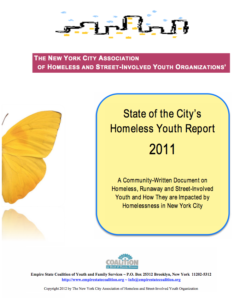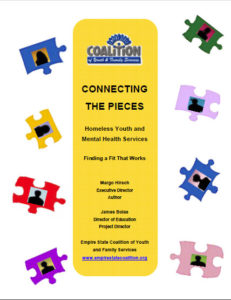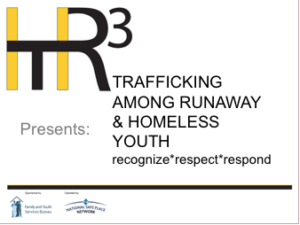A great amount of my experience is in Project Management. Within the context of my life, I have always enjoyed managing projects. I always get excited when it comes to Initiating and Planning. In the lat 1980’s, while starting and running HIV Prevention Services for a homeless youth outreach program in Times Square, I really understood the impact of proper Execution and Monitoring of a project! This proved to be helpful when managing the nationwide Rural Youth Outreach Training Project! And because that, and many other projects afterward, had an end-point, I valued the concise cohesion of tying the bow on a job well done!
With a realistically clear start and finish time, projects, when managed efficiently, can become vibrant feathers in a program, organization or agency’s cap!
PAST PROJECTS
The RHY Impact Study
 The RHY Impact Study was a three year multi-setting study of the impact of homeless youth services on homeless youth throughout New York State., funded by the William T. Grant Foundation.
The RHY Impact Study was a three year multi-setting study of the impact of homeless youth services on homeless youth throughout New York State., funded by the William T. Grant Foundation.
State of the City’s Homeless Youth Report (NYC)
 From 2001 – 2012, The State of the City’s Homeless Youth Report 2001 was a bi-annual characterization and evaluation of the issues and sub-populations of runaway and homeless youth in New York City. It analyzed specific policies and gaps in services and made specific recommendations for those services that prove beneficial to disenfranchised youth up to age 24 in NYC.
From 2001 – 2012, The State of the City’s Homeless Youth Report 2001 was a bi-annual characterization and evaluation of the issues and sub-populations of runaway and homeless youth in New York City. It analyzed specific policies and gaps in services and made specific recommendations for those services that prove beneficial to disenfranchised youth up to age 24 in NYC.
The Rural Youth Outreach Training Project (National)
 A training curriculum and manual based upon the national Rural Youth Outreach Training Project that provides strategies and skill development for professionals developing and implementing outreach programs to homeless youth in rural communities. Among other topics it covers Engagement, Approach, Safety, Adolescent Development, Resource Marketing and Communication.
A training curriculum and manual based upon the national Rural Youth Outreach Training Project that provides strategies and skill development for professionals developing and implementing outreach programs to homeless youth in rural communities. Among other topics it covers Engagement, Approach, Safety, Adolescent Development, Resource Marketing and Communication.
(I am currently working on a 2nd Edition of this curricula)
Connecting the Pieces: Homeless Youth and Mental Health Services, Finding a Fit that Works (New York State)

- After interviewing numerous homeless youth and professionals throughout New York State, this report firmly established that homeless youth suffer from mental health disorders in numbers that are grossly disproportionate to that of the general adolescent population, yet the current system of care is not meeting those mental health needs. In response, the report offered a wide range of innovative strategies to pilot going forward. It was our charge to policy makers, service providers, and concerned citizens, to recognize the impending crisis and reinvent how mental health services are provided to our most vulnerable young people.
HTR3 – Trafficking Among Runaway and Homeless Youth: Recognize, Respect and Respond (National)
 The HTR3 project goals focused on building capacity for Runaway and Homeless Youth (RHY) federal Health and Human Service grantees to address the needs of victims/survivors of human trafficking and filling the knowledge gap for RHY grantees rather than recreating the numerous resources already available at the local, state and national levels. This included the development and national diffusion of a Training Curriculum and Resource Compendium.
The HTR3 project goals focused on building capacity for Runaway and Homeless Youth (RHY) federal Health and Human Service grantees to address the needs of victims/survivors of human trafficking and filling the knowledge gap for RHY grantees rather than recreating the numerous resources already available at the local, state and national levels. This included the development and national diffusion of a Training Curriculum and Resource Compendium.
Non-Drivers Identification Campaign
- This statewide campaign changed Department of Motor Vehicles policy by reducing the number of points required for homeless youth to obtain a non-driver photo identification by allowing certified Runaway and Homeless Youth Programs the right to vouch as one source of their identity. Through research for the 2009 State of the City Report, we found that the non-driver state ID was the main form of identification recognized in New York State. Not having this ID presented a formidable barrier to gaining employment, or eligibility for government programs. For young persons living in precarious social conditions (read: homeless and disenfranchised), gathering the many necessary documents to satisfy the DMV’s then current criteria presented an extraordinary obstacle to stabilizing their lives. This Project focused on building a statewide voice with collaborative data. Through extensive meetings we were able to negotiate this expanded access for Homeless and Runaway Youth, a population that is often forgotten or ignored.